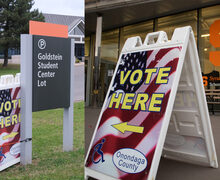2 Syracuse University teams compete in 1st EnergyTech University Prize
Daily Orange File Photo
Vanessa Z. Chan, the director of the Office of Technology Transitions, said that the goal of the national collegiate competition is to strengthen the energy innovation community in the U.S., help young entrepreneurs by providing them with business opportunities and create a pipeline for the nation’s energy future.
Get the latest Syracuse news delivered right to your inbox.
Subscribe to our newsletter here.
The Office of Technology Transitions of the U.S. Department of Energy recently sponsored the EnergyTech University Prize, a national collegiate competition for student teams to develop and present a business plan for a high-potential energy technology. Of the 19 teams who competed, two represented Syracuse University.
On Friday, the Regional round of the competition took place virtually, with 19 teams presenting at the New York Tri-State Regional Explore Event. The two Syracuse teams presented their ideas, which centered around Wireless Control System for Residences and Electromagnetic Power Generation Using Treadmills.
EnergyTech UP awarded more than $250,000 in cash prizes to teams that effectively offered new innovation to an existing energy technology, assessed its market potential and proposed a commercialization strategy. Moreover, teams will receive tailored mentorship and Energy I-Corp materials. They will directly work with the DOE and national laboratories to further develop business plans specifically for the energy industry, and they will network with industry professionals at Carnegie Mellon University’s Energy Week.
At the end, the judges selected the winners that will continue to the national competition in March. This year’s regional winner of EnergyTech UP was the “Smart i-floor” from the University of Connecticut. The technology uses the pressure of people walking on a special pad to generate an electrical signal, which is then used for many purposes.
Eric Allan Schiff, the moderator and host of the New York Tri-State Regional Explore Event and the executive director of the Syracuse University Center of Excellence in Environmental & Energy Systems (SyracuseCoE) — which is focused on clean and renewable energy technology — said he was eager to announce the start of the competition.
“Our event at Syracuse was for students from the states of New York, Connecticut and New Jersey,” Schiff said. “We’re one of 11 Centers of Excellence funded by New York State.”
“Wireless Control System for Residences” is a wireless microcontroller that controls power supply to appliances and other devices in a user’s home for energy cost savings. Their team captain, Yiwei Ling, is a senior majoring in electrical engineering. She learned about the EnergyTech UP competition through her professor, Tomislav Bujanovic, who teaches ELE 415. Through Bujanovic’s class, Ling teamed up with two of her peers.
“We were a little bit of nervous, considering our group was going second, but we went well under the pressure,” Ling said. “I thought it was a research competition, but EnergyTech seems to actually (be) looking for a bit more business project design, so we did not pass the regional. It was (a) great learning experience though.”
“Electromagnetic Power Generation Using Treadmills” is based on the design of an electromagnetic treadmill that will feed power to buildings such as homes and schools, low-income areas and their local micro-grid. Their team captain, Dylan Palmer, is also a senior majoring in electrical engineering. Palmer heard about the EnergyTech UP competition from the same class as Ling.
“I was motivated to apply because it seemed like a good opportunity to study a new business approach for technology that I haven’t been exposed to in my undergraduate degree yet,” Palmer said. “Presenting in the competition was pretty nerve racking because there were so many other students and professionals.”
Vanessa Z. Chan is the director of The Office of Technology Transitions and the Department of Energy’s chief commercialization officer. She is in charge of all commercialization activities at the DOE, the 17 national laboratories and the department’s other research and manufacturing centers across the country in her position. Chan said she was beyond excited to see the amazing turn out for the first ever EnergyTech UP competition.
“In fact, with 180 total applications from 113 schools, our inaugural quadrant of teams represents 42 states, plus the District of Columbia and Puerto Rico,” Chan said. “My vision for the goals and outcomes of this competition are one, to strengthen the energy innovation community across the US and (its) territories, two, to identify business opportunities for young entrepreneurs, and three, to help lay a talent pipeline that will secure our energy future.”
DISCLAIMER: Adriana Lobo was the Student Association’s community engagement co-chair. She no longer occupies this position.
Published on February 22, 2022 at 11:03 pm






